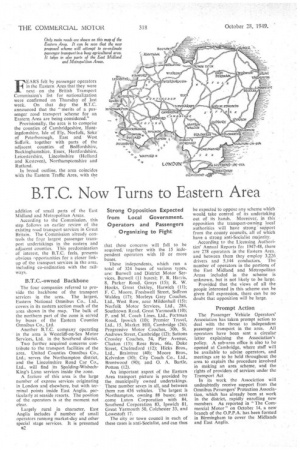B.T.C. Now Turns to Eastern Area
Page 36

If you've noticed an error in this article please click here to report it so we can fix it.
Strong Opposition Expected from Local Government. Operators and Passengers Organizing to Fight
FEARS felt by passenger operators in theEastern Area that they were next on the British Transport Commission's list for nationalization were confirmed on Thursday of last week. On that day the B.T.C. announced that the " merits of a passenger road transport ' scheme for an Eastern Area are being considered."
Provisionally, the area is to comprise the counties of Cambridgeshire, Huntingdonshire, Isle of Ely, Norfolk, Sokc of Peterborough, East and West Suffolk, together with parts of the adjacent counties of Bedfordshire, Buckinghamshire, Essex, Hertfordshire, Leicestershire, Lincolnshire (Holland and Kesteven), Northamptonshire and Rutland.
In broad outline, the area coincides with the Eastern Traffic Area, with the addition of small parts of the East Midland and Metropolitan Areas.
According to the Commission, this step follows an earlier review of the existing road transport services in Great Britain. The Commission already controls the four largest passenger transport undertakings in the eastern and adjacent counties. This predomination of interest, the B.T.C. feels, presents obvious opportunities for a closer linkup of the transport services in the area, including co-ordination with the railways.
B.T.C.-owned Backbone
The four companies referred to provide the backbone of the transport services in the area. The largest, Eastern National Omnibus Co., Ltd., covers in its eastern section much of the area shown in the map. The bulk of the northern part of the zone is served by buses of the Eastern Counties Omnibus Co.. Ltd.
Another B.T.C. company operating in the area is Westcliff-on-Sea Motor Services, Ltd. in the Southend district.
Two further acquired concerns contribute to the transport facilities of the area. United Counties Omnibus Co., Ltd.; serves the Northampton district, and the Lincolnshire Road Car Co., Ltd., will find its Spalding-WisbechKing's Lynn services inside the zone.
A feature of this area is the large number of express services originating in London and elsewhere, but with terminal points inside East Anglia, particularly at seaside resorts. The position of the operators is at the moment not clear.
Largely rural in character, East Anglia includes al number of small operators running market-day and other special stage services. It is presumed
r12
that these concerns will fall to be acquired, together with the 15 independent operators with 10 or more buses.
These independents, which run a total of 324 buses of various types, are: Burwell and District Motor Services, Burwell (11 buses); F. R. Harris, 8, Parker Road, Grays (15); R. W. Hooks, Great Oakley, Harwich (11); F. C. Moore, Freshwell Street, Saffron Walden (17); Moneys Grey Coaches, Ltd., West Row, near Mildenhall (15); Norfolk Motor Services, Ltd, 284, Southtown Road, Great Yarmouth (10); P. and M. Coach Lines, Ltd., Portman Road, Ipswich (10); Premier Travel, Ltd., 15, Market Hill, Cambridge t26); Progressive Motor Coaches, 30b, St. Andrews Street, Cambridge (12); Suttons Crossley Coaches, 54, Pier Avenue, Clacton (13); Rose Bros., 66a, Duke Street, Chelmsford (12); Hicks Bros., Ltd., Braintree (40); Moore Bros., Kelvedon (10); City Coach Co., Ltd., Brentwood (90); and O. A. Bartle, Potion (12).
An important aspect of the Eastern Area transport picture is provided by the municipally owned undertakings. These number seven in all, and between them run 436 vehicles. The largest is Northampton, owning 88 buses:. next come Luton Corporation with 84, Southend Corporation 83, Ipswich 81. Great Yarmouth 50, Colchester 33. and Lowestoft 17.
The city or town council in each of these cases is anti-Socialist, and can thus
be expected to oppose any scheme which would take control of its undertaking out of its hands. Moreover, in this opposition the transport-owning local. authorities will have strong ' support from the county councils, all of which have a strong anti-Socialist majority.
According to the Licensing Authorities' Annual Reports foi 1947,48, there are 278 operators in the Eastern Area, and between them they employ 3,226 _ drivers and 5,144 conductors. The number of operators in the portions of the East Midland and Metropolitan Areas included in the scheme is unknown, but is not likely to be large.
Provided that the views of all the people interested in this scheme can be given full expression, there can be no doubt that opposition will be large.
Prompt Action The Passenger Vehicle Operators' Association has taken prompt action to deal with the threat to independent passenger transport in the area. All operators have been sent a circular letter explaining the Association's policy. A sub-area office is also to be opened at Cambridge, where staff will be available to advise operators, and meetings are to be held throughout the area to explain the procedure involved in making an area scheme, and the rights of providers of services under the Transport Act.
In its work the Association will undoubtedly receive support from the Omnibus Passengers' Protection Association, which has already been at work in the district, rapidly enrolling new members As reported in "The Commercial Motor" on October 14, a new branch of the 0.P.P.A. has been formed in Birmingham to cover the Midlands and East Anglia.




























































































